2010 TOYOTA YARIS steering wheel
[x] Cancel search: steering wheelPage 305 of 400
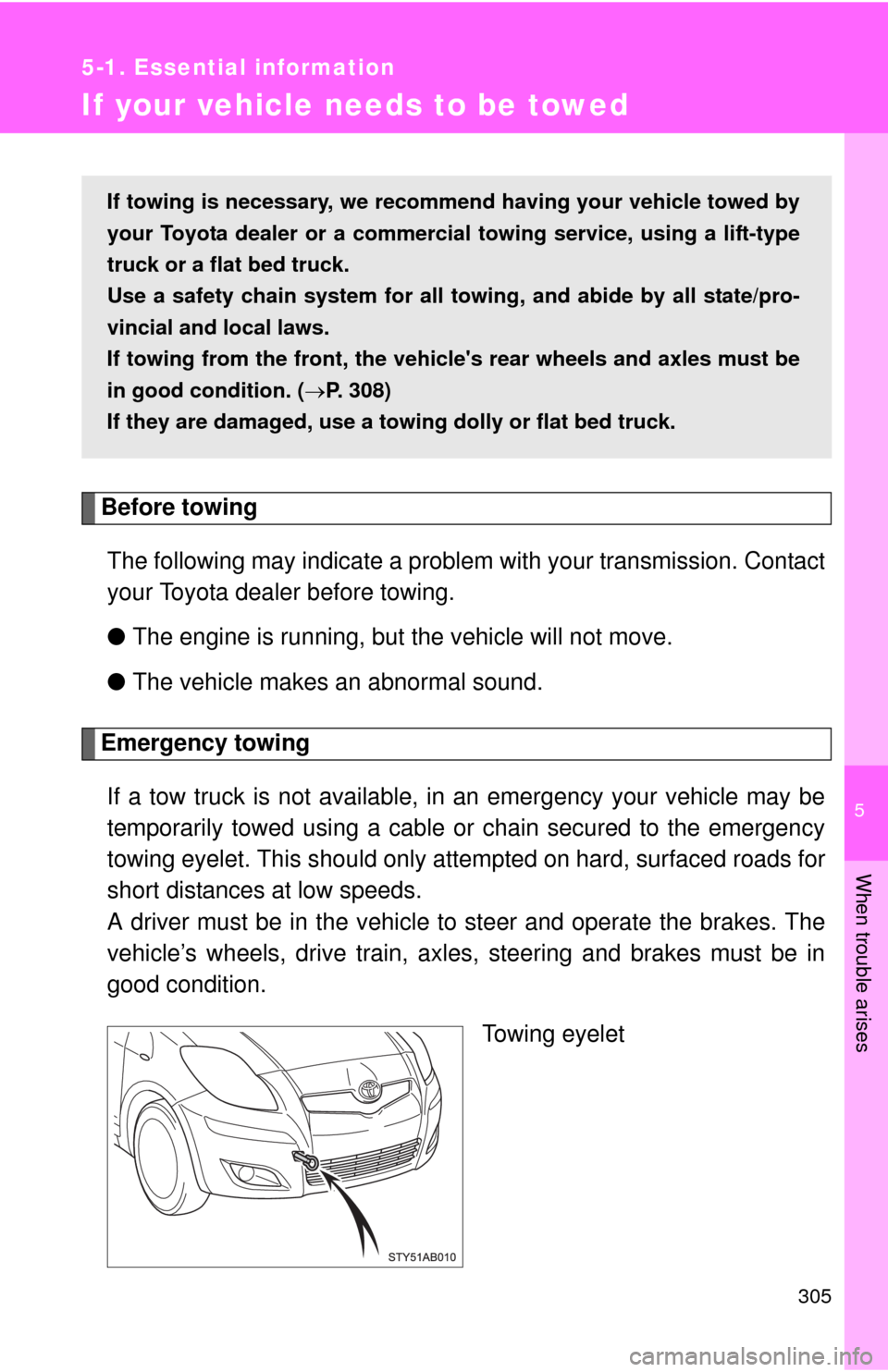
5
When trouble arises
305
5-1. Essential information
If your vehicle needs to be towed
Before towing
The following may indicate a problem with your transmission. Contact
your Toyota dealer before towing.
●The engine is running, but the vehicle will not move.
●The vehicle makes an abnormal sound.
Emergency towing
If a tow truck is not available, in an emergency your vehicle may be
temporarily towed using a cable or chain secured to the emergency
towing eyelet. This should only attempted on hard, surfaced roads for
short distances at low speeds.
A driver must be in the vehicle to steer and operate the brakes. The
vehicle’s wheels, drive train, axles, steering and brakes must be in
good condition.
Towing eyelet
If towing is necessary, we recommend having your vehicle towed by
your Toyota dealer or a commercial towing service, using a lift-type
truck or a flat bed truck.
Use a safety chain system for all towing, and abide by all state/pro-
vincial and local laws.
If towing from the front, the vehicle's rear wheels and axles must be
in good condition. (P. 308)
If they are damaged, use a towing dolly or flat bed truck.
Page 306 of 400
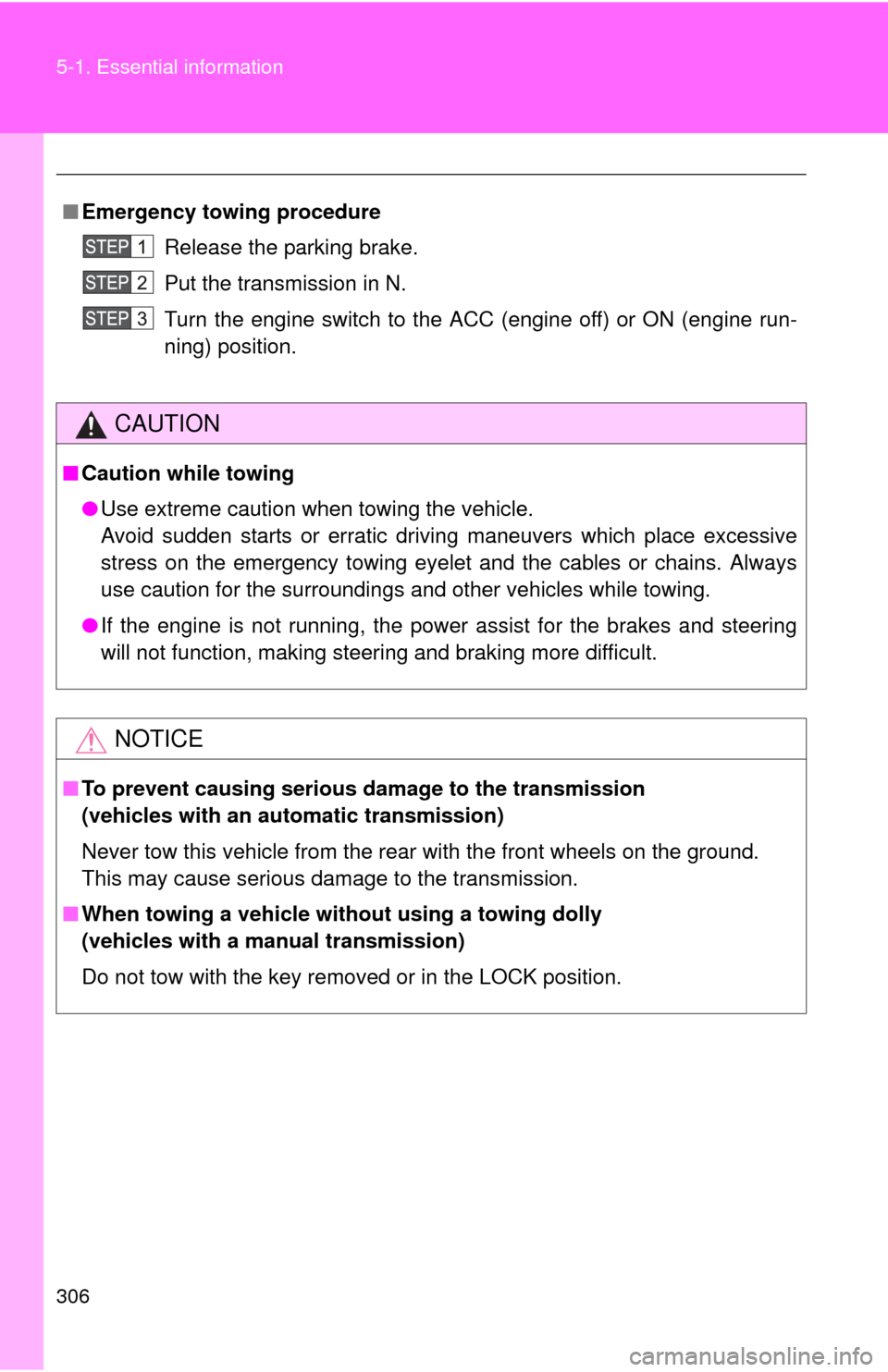
306 5-1. Essential information
■Emergency towing procedure
Release the parking brake.
Put the transmission in N.
Turn the engine switch to the ACC (engine off) or ON (engine run-
ning) position.
CAUTION
■Caution while towing
●Use extreme caution when towing the vehicle.
Avoid sudden starts or erratic driving maneuvers which place excessive
stress on the emergency towing eyelet and the cables or chains. Always
use caution for the surroundings and other vehicles while towing.
●If the engine is not running, the power assist for the brakes and steering
will not function, making steering and braking more difficult.
NOTICE
■To prevent causing serious damage to the transmission
(vehicles with an automatic transmission)
Never tow this vehicle from the rear with the front wheels on the ground.
This may cause serious damage to the transmission.
■When towing a vehicle without using a towing dolly
(vehicles with a manual transmission)
Do not tow with the key removed or in the LOCK position.
Page 309 of 400
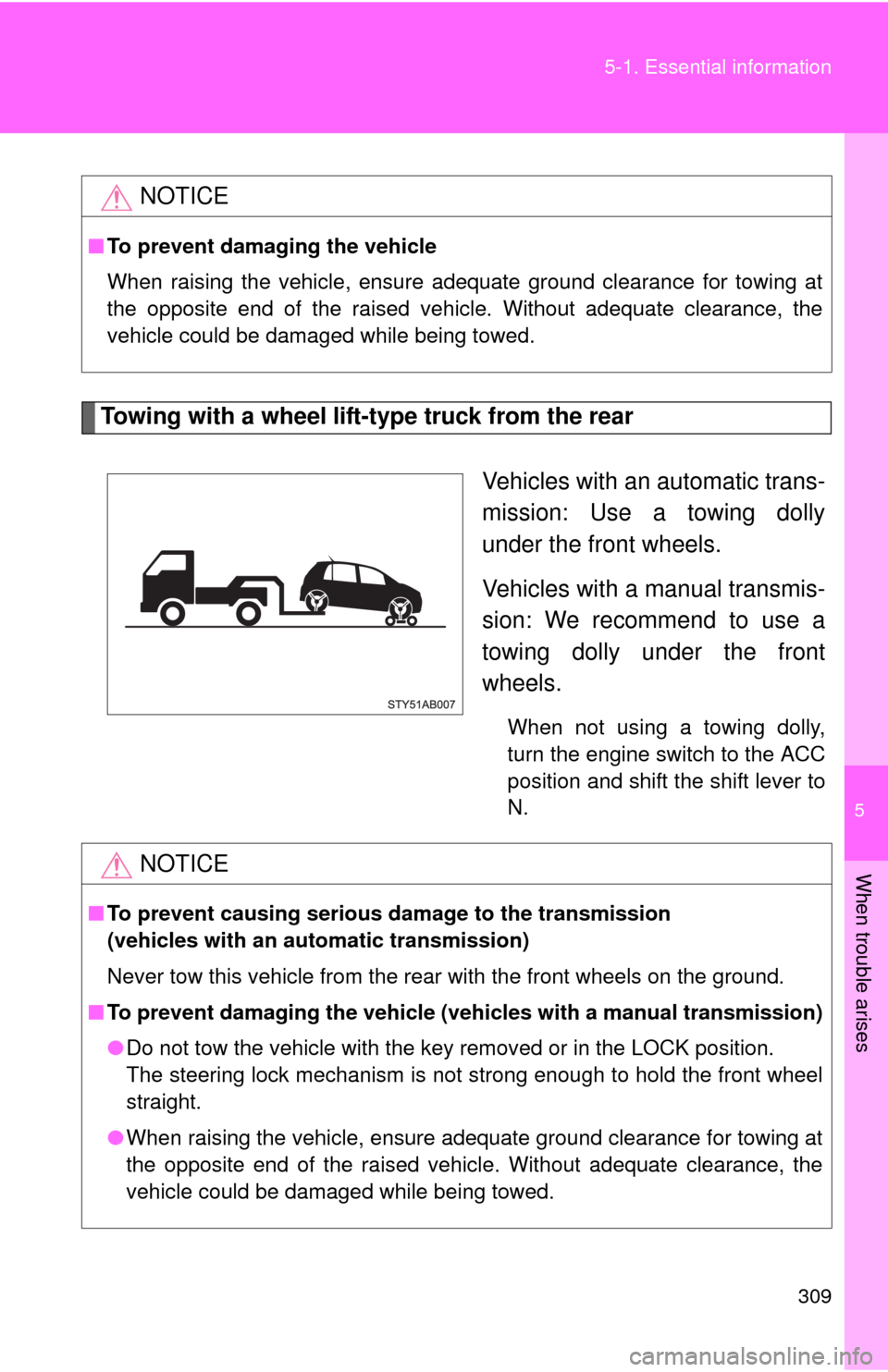
5
When trouble arises
309 5-1. Essential information
Towing with a wheel lift-type truck from the rear
Vehicles with an automatic trans-
mission: Use a towing dolly
under the front wheels.
Vehicles with a manual transmis-
sion: We recommend to use a
towing dolly under the front
wheels.
When not using a towing dolly,
turn the engine switch to the ACC
position and shift the shift lever to
N.
NOTICE
■To prevent damaging the vehicle
When raising the vehicle, ensure adequate ground clearance for towing at
the opposite end of the raised vehicle. Without adequate clearance, the
vehicle could be damaged while being towed.
NOTICE
■To prevent causing serious damage to the transmission
(vehicles with an automatic transmission)
Never tow this vehicle from the rear with the front wheels on the ground.
■To prevent damaging the vehicle (vehicles with a manual transmission)
●Do not tow the vehicle with the key removed or in the LOCK position.
The steering lock mechanism is not strong enough to hold the front wheel
straight.
●When raising the vehicle, ensure adequate ground clearance for towing at
the opposite end of the raised vehicle. Without adequate clearance, the
vehicle could be damaged while being towed.
Page 322 of 400

322 5-2. Steps to take in an emergency
■Customization that can be configured at Toyota dealer
●The vehicle speed linked seat belt reminder buzzer can be disabled.
(Customizable features P. 377)
●The key reminder buzzer can be disabled.
(Customizable features P. 377)
●The light reminder buzzer can be disabled.
(Customizable features P. 377)
CAUTION
■If the tire pressure warning light comes on
Be sure to observe the following precautions. Failure to do so could
cause loss of vehicle control and result in death or serious injury.
●Stop your vehicle in a safe place as soon as possible. Adjust the tire
inflation pressure immediately.
●If the tire pressure warning light comes on even after tire inflation pres-
sure adjustment, it is probable that you have a flat tire. Check the tires.
If the tire is flat, change to the spare tire and have the flat tire repaired
by the nearest Toyota dealer.
●Avoid abrupt maneuvering and braking. If the vehicle tires deteriorate,
you could lose control of the steering wheel or the brakes.
■If a blowout or sudden air leakage should occur
The tire pressure warning system may not activate immediately.
■Maintenance of the tire
Each tire, including the spare (if provided), should be checked monthly
when cold and inflated to the inflation pressure recommended by the
vehicle manufacturer on the vehicle placard or tire inflation pressure
label (tire and load information label). (If your vehicle has tires of a differ-
ent size than the size indicated on the vehicle placard or tire inflation
pressure label [tire and load information label], you should determine the
proper tire inflation pressure for those tires.)
Page 350 of 400
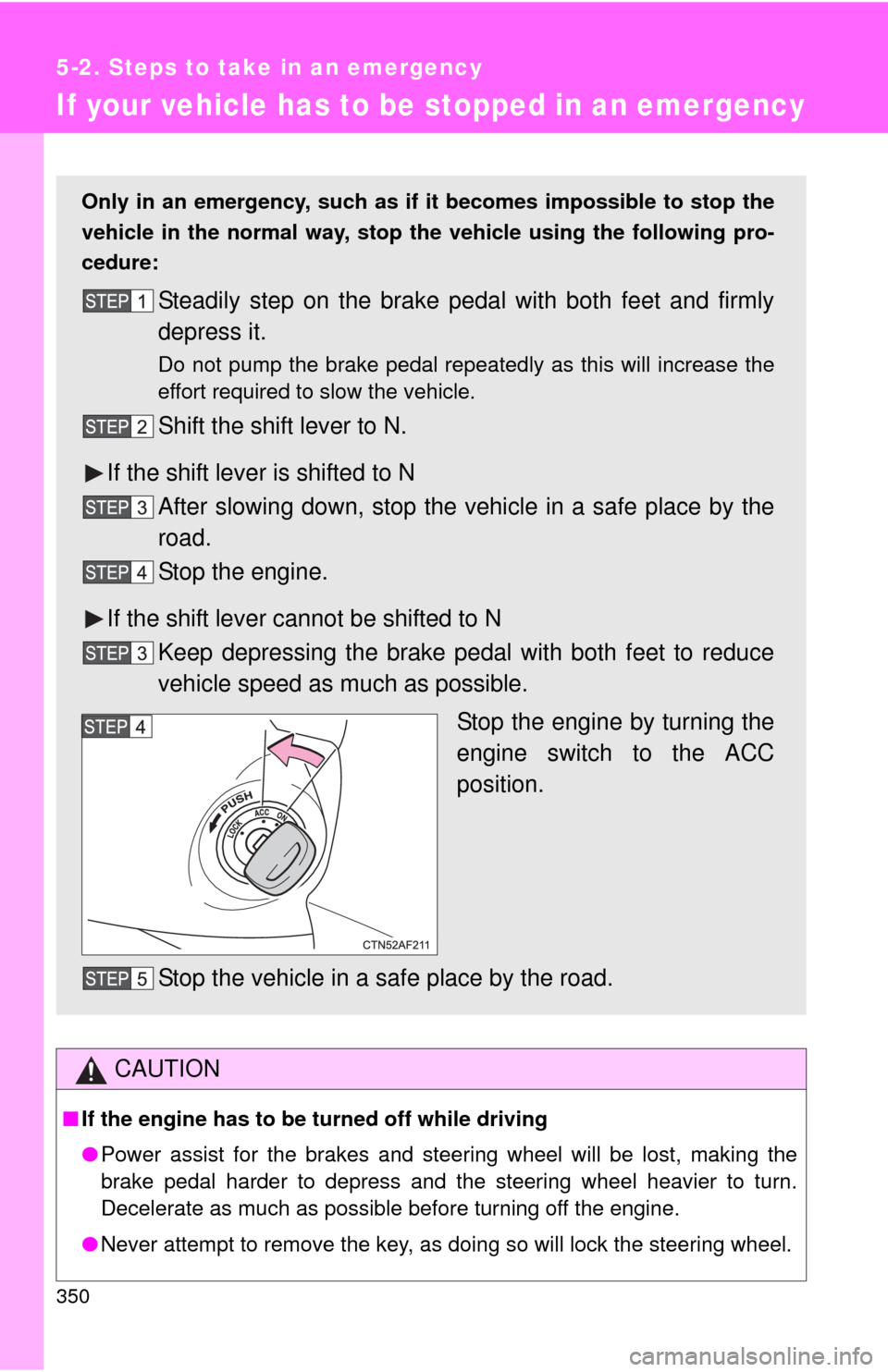
350
5-2. Steps to take in an emergency
If your vehicle has to be stopped in an emergency
CAUTION
■If the engine has to be turned off while driving
●Power assist for the brakes and steering wheel will be lost, making the
brake pedal harder to depress and the steering wheel heavier to turn.
Decelerate as much as possible before turning off the engine.
●Never attempt to remove the key, as doing so will lock the steering wheel.
Only in an emergency, such as if it becomes impossible to stop the
vehicle in the normal way, stop the vehicle using the following pro-
cedure:
Steadily step on the brake pedal with both feet and firmly
depress it.
Do not pump the brake pedal repeatedly as this will increase the
effort required to slow the vehicle.
Shift the shift lever to N.
If the shift lever is shifted to N
After slowing down, stop the vehicle in a safe place by the
road.
Stop the engine.
If the shift lever cannot be shifted to N
Keep depressing the brake pedal with both feet to reduce
vehicle speed as much as possible.
Stop the engine by turning the
engine switch to the ACC
position.
Stop the vehicle in a safe place by the road.
Page 359 of 400
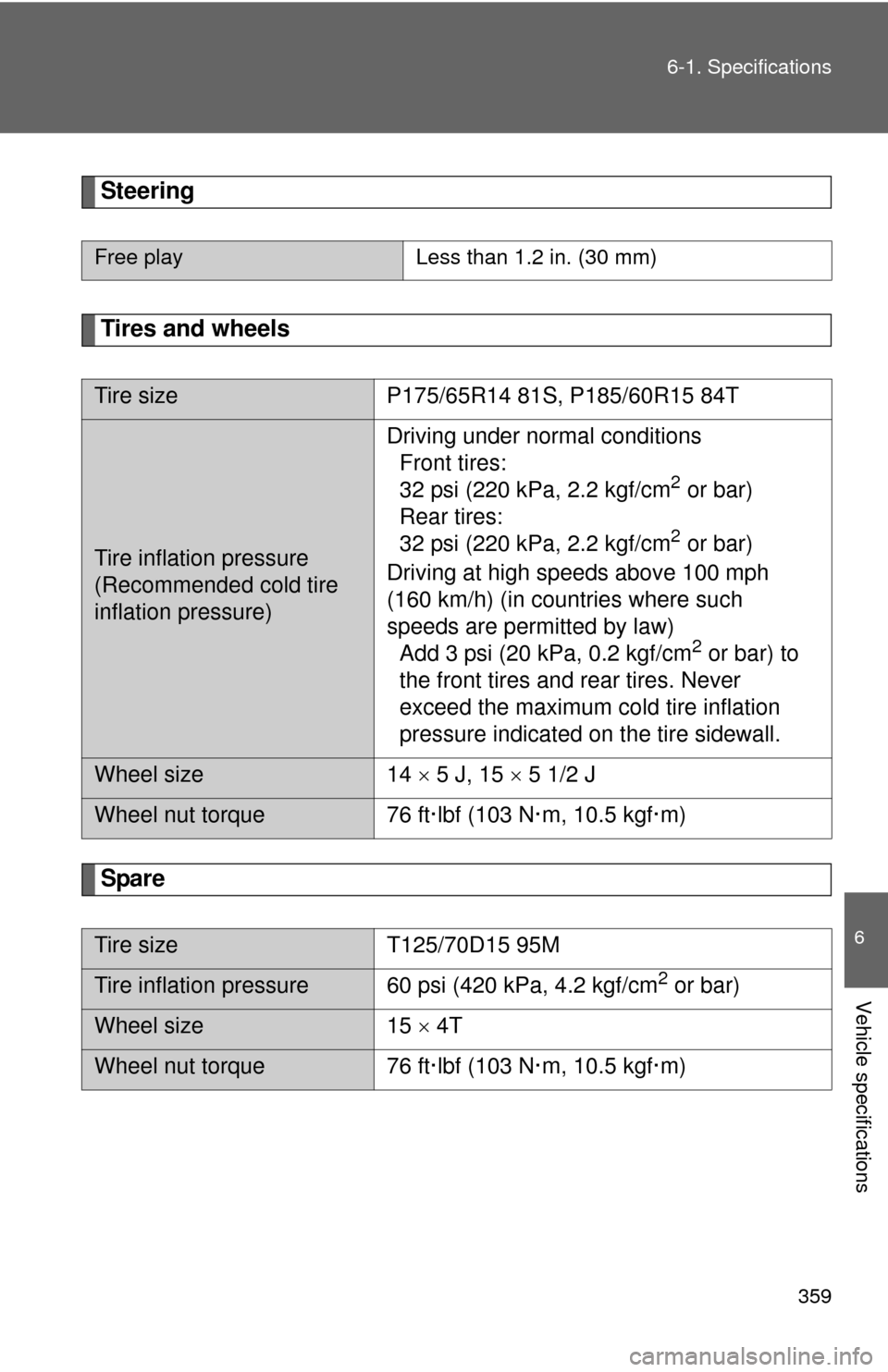
359 6-1. Specifications
6
Vehicle specifications
Steering
Tires and wheels
Spare
Free play Less than 1.2 in. (30 mm)
Tire size P175/65R14 81S, P185/60R15 84T
Tire inflation pressure
(Recommended cold tire
inflation pressure)Driving under normal conditions
Front tires:
32 psi (220 kPa, 2.2 kgf/cm
2 or bar)
Rear tires:
32 psi (220 kPa, 2.2 kgf/cm
2 or bar)
Driving at high speeds above 100 mph
(160 km/h) (in countries where such
speeds are permitted by law)
Add 3 psi (20 kPa, 0.2 kgf/cm
2 or bar) to
the front tires and rear tires. Never
exceed the maximum cold tire inflation
pressure indicated on the tire sidewall.
Wheel size 14 5 J, 15 5 1/2 J
Wheel nut torque 76 ft·lbf (103 N·m, 10.5 kgf·m)
Tire size T125/70D15 95M
Tire inflation pressure 60 psi (420 kPa, 4.2 kgf/cm2 or bar)
Wheel size 15 4T
Wheel nut torque 76 ft·lbf (103 N·m, 10.5 kgf·m)
Page 394 of 400

394 Alphabetical index
Seat belts
Adjustment ..............................57
ALR .........................................61
Automatic Locking Retractor ...61
Child restraint system
installation ................... 102, 106
Cleaning and maintaining...... 240
Comfort guide..........................59
ELR .........................................61
Emergency Locking
Retractor .............................. 61
How to wear your seat belt......56
How your child should wear
the seat belt ..........................62
Pregnant women, proper seat
belt use .................................62
Reminder light ....................... 318
Seat belt extenders .................62
Seat belt pretensioners ...........61
Seats
Adjustment ..............................40
Adjustment precautions........... 42
Child seats/child restraint
system installation ...... 102, 106
Cleaning ................................ 238
Folding down the rear seat......45
Folding down the rear seat
precautions ...........................49
Front seat adjustment .............40
Front seat adjustment
precautions ...........................42
Head restraint..........................50
Properly sitting in the seat .......83
Service reminder
indicators .............................. 145
Shift lever
Automatic transmission ......... 132
If the shift lever cannot be
shifted from P...................... 339
Manual transmission ............. 134
Shift lock system..................... 339
Side airbags................................85Side marker lights
Replacing light bulbs ............. 294
Switch ................................... 149
Wattage................................. 360
Side mirror
Adjusting ................................. 68
Defogger ............................... 193
Folding .................................... 69
Spare tire
Identification number............. 364
Inflation pressure .......... 272, 359
Information ............................ 364
Replacing .............................. 325
Size ....................................... 359
Storage location .................... 325
Spark plug ................................ 356
Specifications .......................... 352
Speedometer ............................ 139
Steering wheel
Adjustment .............................. 66
Column lock release ............. 130
Electric power steering.......... 160
EPS ....................................... 160
Specification.......................... 359
Warning light ......................... 316
Stop lights
Replacing light bulbs ............. 294
Wattage................................. 360
Storage features
Auxiliary boxes .............. 220, 225
Bottle holders ................ 220, 223
Cup holders................... 220, 222
Glove boxes .................. 220, 221
Storage precautions ................ 167
Stuck
If the vehicle becomes
stuck ................................... 348
Sun visors ................................ 227
Switch
Cruise control ........................ 156
Emergency flashers
switch.................................. 304
Engine switch ........................ 129S